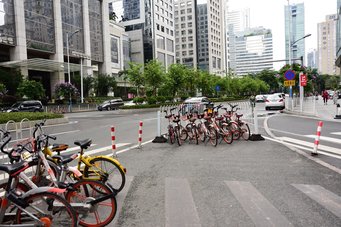
A history of bicycle mobility in urban China: Shared bikes, technology, and infrastructure (Part 2 of 2)
Jun Zhang
Zhang, Jun. 2022. A history of bicycle mobility in urban China: Shared bikes, technology, and infrastructure (Part 2 of 2). MoLab Inventory of Mobilities and Socioeconomic Changes. Department ‘Anthropology of Economic Experimentation’. Halle/Saale: Max Planck Institute for Social Anthropology. https://doi.org/10.48509/MoLab.1288
Download as PDF
When talking about public train or tram systems, massive, networked infrastructures such as rails and stations may immediately come to mind. In contrast, the images conjured up in discussions about bicycle mobility are of apparently free-floating individuals riding about on their bikes. Yet, just like automobility, bicycle mobility entails a range of infrastructures—from physical items such as bicycles and locks to parking docks and lanes, as well as non-material structures such as regulations, discourses, perceptions, and codes of conduct. The ways in which these material and non-material infrastructures are built and connected are shaped by specific historical forces.
In the first entry (www.eth.mpg.de/molab-inventory/mobility-infrastructure/history-of-bicycle-mobility-in-urban-China-part-one) on bicycle mobility in urban China, I trace how the changing visions and practices of urban development have shaped and reshaped urban environments as China has transformed from a kingdom of bicycles to a country of cars. Building on that history, which covers the period from the 1970s until today, this second entry examines a new form of bicycle mobility which emerged in 2014. That is, mobility based on shared bicycles. Bicycle mobility, like automobility, is conventionally understood as a private or individualized form of mobility. Yet bike sharing programs, often operated through public-private partnerships, provide a flexible form of “public” transit. In the last two decades, bike sharing programs have sprung up in a number of cities around the world. Drawing on fieldwork in urban areas of the Pearl River Delta region in China, this entry illustrates the role of “dockless” shared bike schemes run by private technology companies in the daily lives of residents. I argue that in cities where there is no large scale infrastructural support for cycling, shared bicycles may not be as environmentally friendly or healthy as one might expect.
The rise of shared bikes
Many scholars trace bike sharing to the White Bike Plan, associated with the anarchist movement Provo, in Amsterdam in 1965. Seeking to promote cycling whilst overcoming the key issues associated with bicycles, such as theft and costs, bike sharing programs evolved from free-standing bicycles available free of charge to the use of electronic docking stations and electric bicycles paid for via credit card. Over time, bike sharing has gradually found support not only from influential politicians and social activists seeking to develop integrated transit systems, but also corporate interests.[1] By the time bike sharing arrived in US cities in the 2010s, urban planners had started to envision it as a means transforming mobility in an era of urban redevelopment. Today, many bike sharing projects around the world are public-private partnerships. The launch of a bike sharing project typically involves careful urban planning and sometimes community engagement, especially regarding the location of docking stations.[2] Thus, it is understandable that most bike sharing projects are at least partially operated by the city.
Shared bikes programs, commonly known as gongxiang danche, emerged in China in the mid-2010s.[3] Unlike most schemes abroad, shared bikes in China did not require docking stations, meaning users could drop them off anywhere. The cycles were embedded with a GPS-chip, allowing users to find them using a smartphone app. After registering and making a refundable deposit, users could unlock a bicycle simply by scanning the QR code on the frame. The price was based on the duration of use, and payment was made electronically. In their advertising, shared bike companies promised that they collected transit data to help identify high-demand locations and ensure bicycles were placed in the most needed areas. Empowered by big data and algorithms, shared bike companies extended the hope of a green, flexible, and efficient way of moving around in cities increasingly troubled by constant traffic congestion.
Shared bike projects in China are owned and run by private technology companies. Their launches have involved no urban planning. One of the earliest shared bike companies, Ofo, started in Beijing in 2014 by providing shared bikes to university students, with the stated goal of making campuses car-free. Its main competitor, Mobike, was launched in Shanghai around the same time. Within a short time, dozens of companies had joined the market. Each had its own app and a fleet of bicycles in a distinctive colour. Ofo, for example, was nicknamed the “little yellow bike” (xiaohuangche) (figure 1, 2). In many people’s understandings, shared bike companies were more like Chinese tech giants Meituan or Alibaba than transportation services such as bus or taxi companies.

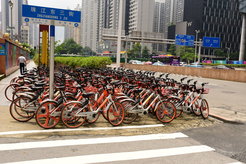
Like many tech start-ups, hundreds of millions of dollars from domestic and international venture capitalists and angel investors were invested in the bike share companies.[4] These investments enabled the companies to expand their fleets rapidly and keep prices down. By 2017, Ofo had one million bicycles in 34 cities. Mobike had five million.[5] That year, there were 2.4 million shared bikes in Beijing alone and by early 2019, there were 23 million shared bikes owned by 77 companies around the country. 95 percent belonged to Ofo and Mobike.[6] To put these numbers in context, Ford GoBike, a shared bike scheme serving an urban cluster including San Francisco, San Jose, Berkeley, Emeryville, and Oakland in the United States, had 7000 bicycles in 2017;[7] and Citi Bike in New York city had around 23,000 bicycles by January 2021.[8] Looking at streets filled with colourful bicycles in the late 2010s, one could have had the impression that China had once again become a bicycle kingdom.
Limited significance of shared bike mobility in a low-cycling context
In US cities like New York, Philadelphia, and Detroit, the popularity of shared bikes reflects a new found interest in bicycle mobility, particularly among white, middle-class professionals. Cycling is seen as part of a healthy, environmentally-friendly lifestyle choice in a car dependent society. At the same time, urban redevelopment has provided some opportunity to reshape infrastructures, making them more bicycle friendly.
In contrast, shared bike schemes arrived in China exactly at a moment when cycling infrastructure, as I show in the first entry, had been almost completely marginalized in the process of growth-oriented urbanization. For many citizens, the new form of pedal mobility enabled by shared bikes did not embody a distinctive lifestyle choice, an attitude toward the environment, or urban mobility. Instead, shared bikes were often understood simply as supplementary to the public transit system. Specifically, shared bikes provided a means to cover the “last-kilometre” between public transit (bus or subway) and the destination (home or workplace). Almost all my interlocutors who have or do use shared bikes (regularly or irregularly), said they only did so for the “last-kilometre”. This is also how frequently users use shared bikes. For all the kinds of users I spoke to, the biggest advantage of shared bikes was convenience (fangbian). As they did not own the bikes, they did not have to worry about parking, maintenance, theft, and vandalism—all issues that had previously been, thanks to established bicycle infrastructures, comparatively minor during the era of work unit urbanism.
Most frequent users I spoke to were in working-class employment—as janitors, cleaning staff, taxi drivers. They usually lived in urban villages far from the downtown areas or their workplaces. Despite being encroached on by the sprawling cities, urban villages retain their collective land ownership and institutional rural status. Although the margins of the cities often provide cheap housing for migrant workers, they remain urban villages typically poorly connected to the municipal public transportation system. In the past, motorbikes-for-hire, which have been outlawed in Guangzhou and other cities, had connected urban village residents to nearby public transit stations. The last few years, however, have seen these motorbikes-for-hire significantly lose business to the cheaper shared bikes.
Despite the relatively high demand for shared bikes, however, it is not always easy to find one in these areas. Shared bike projects tend to place significantly fewer bicycles in peripheral areas, favouring instead highly populated and economically vibrant locations typically well served by an array of transit options. As a result, like shared bike projects in US cities, shared bike projects tend to reproduce the imbalanced development of Chinese cities.
Many of my middle-class interlocutors sang the praises of shared bikes after they appeared on the streets. They had picked up a shared bike near the bus or subway station and ridden it to work. Riding shared bikes was also a popular option when going out for lunch with colleagues or running some errands. Some interlocutors told me that they enjoyed using the bikes to explore a city they were visiting. That said, none of them used shared bikes on a daily basis. And some of those who enthusiastically recommended the bikes to me did not, in fact, use them regularly. But there were some clear trends: the younger of my middle-class interlocutors tended to use shared bikes more than the older, and the men tended to show more enthusiasm and use them more than the women. Judging by the way my interlocutors talked about the bikes and their emphasis on the technological features, my impression was that they were more fascinated by shared bikes for their embodiment of technological advancement than as a sustainable form of urban transportation.
For most shared bike users I spoke to, cycling was generally seen as dangerous, especially because the streets were full of cars, most of which are being driven by first-time drivers. With the disappearance of dedicated cycle lanes, riders often felt unsure about where exactly they should ride on the streets, especially when there was no clear signage (figures 3, 4, 5). As cars typically park along the curb, cyclists are often pushed into the centre of the road where they have to compete with moving vehicles. While cycling was a form of exercise, many did not see it as a healthy option because they would have to inhale the notoriously poor city air and the exhaust fumes. Some middle-class interlocutors, particularly women, also suggested that cycling to work was unrealistic in the southern cities where the summer is long, hot, and humid. Their workplaces typically lacked shower facilities, and they would feel embarrassed and uncomfortable walking into their offices covered in sweat.
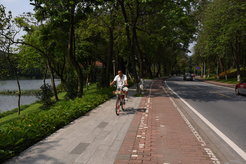

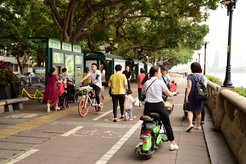
Shared bicycle users share all these concerns with cyclists who own their own bikes. Moreover, functional sophistication, manoeuvrability, and comfort are sacrificed in shared bikes to serve demands for sturdiness and low maintenance. My interlocutors, regardless of their socioeconomic backgrounds, could not see themselves riding a shared bicycle for a long distance. In short, shared bikes provide a convenient option for urban mobility as long as the ride is short and busy streets can be avoided. Like a number of shared bike projects in cities around the world, shared bikes in China have not replaced driving, but rather walking or other informal means of mobility serving groups living at urban margins.
Infrastructure troubles
As the initial enthusiasm for shared bikes receded, a number of issues began to surface. One was the companies predatory use of public space, especially spaces for pedestrians. As stated above, while many shared bicycle projects seek planning approval for the use of public space, shared bike projects in Chinese cities did not coordinate their operations with urban planning agencies. Bicycles were simply planted in open public spaces, especially on footpaths and between buildings (figures 6, 7). Residents were initially often curious about the bicycles and tolerated them. However, as time passed and the numbers of bicycles increased rapidly, problems arose. Residents started to complain that they clogged up leisure spaces and footpaths, forcing pedestrians out onto the road; street cleaners resented how difficult the bikes made their work; and some residential complexes explicitly forbade shared bikes from entering their compounds.
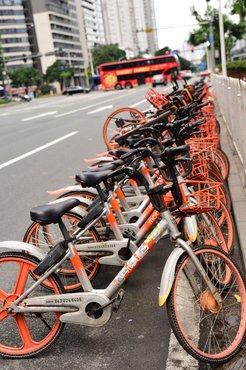
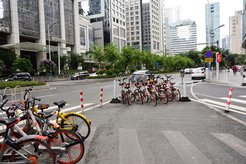
As the number of shared bikes grew exponentially, it did not take long before the issue of waste caught public attention. Funded by venture capital, Ofo and Mobike followed a common practice employed by tech startups like Uber: try to swallow up as large a market share as possible, long before any profit has been made. Following this logic, companies invested heavily in putting as many bicycles as possible into cities. Many share bike programs in other societies adopt the practice of rebalancing, that is, moving bicycles to and placing them in different locations, thereby seeking to maximize the use of each bicycle. Yet while the companies in China sometimes outsourced rebalancing work to individual contractors, their main strategy was to replenish streets and open spaces with new bicycles in locations where they believed demand would be high, such as major subway exits in downtown areas.
Moreover, shared bike companies were not especially interested in carrying out maintenance. While the bicycles were designed to be robust, they did need some maintenance due to careless use or, in some cases, vandalism. For example, motorcycle riders, who felt their businesses jeopardized by the bikes, would intentionally vandalise them or even throw them into the river. Rather than performing maintenance, the companies simply left many of the broken bicycles in the streets while shipping in new ones. In other words, the issue of maintenance, which could have been dealt with through labour and care was handled in a capital-intense manner: bicycles were treated like fast fashion—buying new instead of fixing.
The lack of rebalancing and maintenance led to a number of bicycles being disposed of or abandoned, even in populated areas of the cities (figures 8, 9). The issue of abandoned bicycles became steadily worse in 2017 and 2018, as the growth-first strategy turned out to be unsustainable. Many shared bike companies got into financial trouble and went bankrupt, and some registered users were unable to get their deposits back. Mobike was acquired by Meituan, another tech company. Ofo stopped operating altogether. And photos of large-scale “bicycle cemeteries” began to appear in the media.[9]

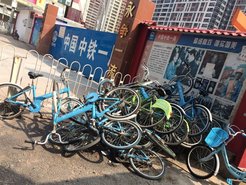
By the late 2010s, and with complaints abounding in local media, local governments had started to intervene. “Clear-up” campaigns were launched in Beijing, Guangzhou, Shenzhen, and other cities, and the number of shared bikes was reduced substantially.[10] Local governments made some effort to control the “unruly growth” of shared bikes by issuing regulations in 2020.[11] However, instead of making systematic efforts to re-introduce cycling infrastructure, regulations focused primarily on parking, the certification of shared bike companies (usually three in one city), and limiting the total numbers of shared bicycles in a city (for example, 800,000 shared bicycles in Beijing’s central districts in 2020).[12] While maintaining control over certification and numbers, municipal governments offloaded the responsibility of enforcing the rules about parking to the companies themselves, asking the latter to oversee whether their users parked the cycles in the designated areas and allowing them to issue fines when they did not.
After the “clear-up” period, certified companies, this time sanctioned by the local governments, filled the streets with bicycles in 2020. Many increased their prices and started charging fines for failing to park properly or for taking cycles beyond the permitted limits. While use grew tangentially amongst the middle class, some of the more price-sensitive frequent users that I spoke to found that shared bikes were no longer a cheaper alternative to public transport and were thus considering cancelling their subscriptions. Yet even with higher prices and limited competition, it remains unclear whether existing shared bike companies will be able to become financially independent of venture capital in the long run.
Conclusion
The United Nations Environment Programme awarded “Champion of the Earth 2017 for Entrepreneurial Vision” to Mobike for “exploring market-driven solutions to air pollution and climate change”. In retrospect, the award was full of irony. The company ran into serious financial trouble one year later. And the bicycles it left behind probably constituted quite a carbon footprint.
While it is too early to call dockless shared bike schemes a complete failure, my ethnographic study tentatively suggests that although shared bikes could be supplementary to the public transit system, their potential as a substitute for automobility is highly limited in the current mode of operation. Shared bike projects, emboldened by venture capital and technology, provide a renewed form of pedal mobility. With the dockless design, they promise the kind of flexibility typically associated with bicycles, but without the hassle of owning and maintaining a bicycle. However, bicycle mobility is not just about bicycles or the technology embedded in them. The viability of bicycle mobility depends on a variety of material and non-material infrastructures. From work unit urbanism to today’s growth-oriented urban development, social and material environments have been substantially reshaped in Chinese cities. Residents’ intra-city mobility patterns have changed—and one of the key changes is that urban residents travel much greater distances than before. With the rapid development of public transportation systems and private car ownership, dominant modes of movement have also changed. Ground transportation has become auto-centred. As existing bicycle infrastructures have been destroyed or transformed, cycling in a low-cycling context is no longer perceived as a safe or healthy way to get around. Mobility provided by shared bikes thus replaces either walking or informal transport arrangements, but plays no significant role in changing or reshaping existing mobility patterns.
Meanwhile, the short history of shared bikes in China—from bankruptcy and bicycle waste to conflicts over space and concerns about prices—suggests that shared bikes are not as hassle-free, flexible, or green as originally promised or envisioned. While the numbers of shared bicycles in cities like Beijing may have dropped after the failure of Ofo and Mobike, one may still want to pause and ask: how many shared bicycles does a city need? Are there more sustainable ways of bringing (back) bicycle mobility without relying on the highly wasteful approach taken by venture capital? To do that seriously, one must be willing to pause and critically reflect on the current paradigm of growth-oriented urban development.
[1] Ploeger, Jan, and Ruth Oldenziel. 2020. The Sociotechnical Roots of Smart Mobility: Bike Sharing since 1965. The Journal of Transport History 41 (2): 134-159.
[2] Stehlin, John G. 2019. Cyclescapes of the Unequal City: Bicycle Infrastructure and Uneven Development. Minneapolis, MN: University of Minnesota Press.
[3] Before the rise of gongxiang danche, some municipal governments had bike sharing projects that used docking stations. But the scale was limited and the schemes not well-known among citizens.
[4] Yang, Yuan. 2017. Mobike takes funding lead in Chinese cycle-sharing. Financial Times. Available online at: https://www.ft.com/content/10d27230-d26f-11e6-9341-7393bb2e1b51. Last accessed 4 March 2022.
[5] Chuxing, Didi. 2017. Private equity puts $600m into Mobike ahead of UK expansion. Financial Times. Available online at: https://www.ft.com/content/4a926312-524a-11e7-a1f2-db19572361bb. Last accessed 4 March 2022.
[6] Feng, Coco and Josh Ye. 2020. The rise and fall of Mobike and Ofo, China’s bike-sharing twin stars. South China Morning Post. Available online at: https://www.scmp.com/tech/start-ups/article/3114932/rise-and-fall-mobike-and-ofo-chinas-bike-sharing-twin-stars?module=perpetual_scroll_0&pgtype=article&campaign=3114932. Last accessed 4 March 2022.
[7] See: Stehlin, John G. 2019. Cyclescapes of the Unequal City: Bicycle Infrastructure and Uneven Development. Minneapolis, MN: University of Minnesota Press, p. 144.
[8] Lyft. 2022. January 2022 Monthly Report. Available online at: https://mot-marketing-whitelabel-prod.s3.amazonaws.com/nyc/January-2022-Citi-Bike-Monthly-Report.pdf. Last accessed 4 March 2022.
[9] Haas, Benjamin. 2017. Chinese bike share graveyard a monument to industry's 'arrogance'. The Guardian. Available online at: https://www.theguardian.com/uk-news/2017/nov/25/chinas-bike-share-graveyard-a-monument-to-industrys-arrogance. Last accessed 11 October 2019; Taylor, Alan. 2018. The Bike-Share Oversupply in China: Huge Piles of Abandoned and Broken Bicycles. The Atlantic. Available online at: https://www.theatlantic.com/photo/2018/03/bike-share-oversupply-in-china-huge-piles-of-abandoned-and-broken-bicycles/556268/. Last accessed 11 October 2019.
[10] For more discussion on this campaign style governance, see Wang, Peng. 2020. "Politics of Crime Control: How Campaign-Style Law Enforcement Sustains Authoritarian Rule in China." The British Journal of Criminology 60 (2): 422-443.
[11] Government information. 2020. Guangzhou gongxiang danche xingui: qiye weigui toufang cheliang zuigao fa 5 wanyuan [New regulations regarding shared bicycles in Guangzhou: Companies that place bicycles against the regulations would be punished at a maximum of 50,000 yuan]. Available online at: https://credit.gz.gov.cn/o/xyxy/content/post_6715577.html. Last accessed 12 March 2022.
[12] Xinhuanet. 2021. Zongliang kongzhi xia, gongxiang danche ruhe youji rongru chengshi? [Under the total-amount control, how are bicycles organically integrated into urban lives?] Available online at: http://www.xinhuanet.com/fortune/2021-05/28/c_1127502979.htm. Last accessed 12 March 2022.
This is an Open Access article, distributed under the terms of the Creative Commons Attribution licence (https://creativecommons.org/licenses/by/4.0/), which permits unrestricted re-use, distribution, and reproduction in any medium, provided the original work is properly cited.






